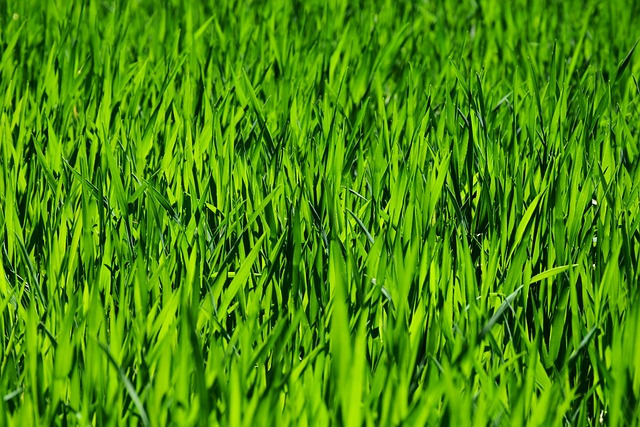To effectively optimize your lawn's irrigation system within Lawn Care and Landscaping practices, it's crucial to assess your property's terrain, soil type, and plant diversity. This enables a customized irrigation design that addresses the unique needs of each part of your land, enhancing water distribution efficiency and promoting a healthy, sustainable lawn while conserving resources. Advanced features like moisture sensors and weather-based programming can further improve system performance by adapting to environmental changes. During planning, accurately mapping your landscape's layout helps determine different zones with varying water requirements, allowing for strategic placement of sprinklers and drip lines for even coverage without excess. Expert advice and precise tools are key to a successful setup, ensuring both the aesthetic appeal and sustainability of your outdoor space. When choosing between professional installation or a DIY approach for your irrigation system, consider the specific needs of your lawn, including its size, terrain, soil composition, and climate. Professional installers offer tailored solutions that conserve water and adhere to environmental standards, while a DIY approach requires thorough research into irrigation products and best practices. Ultimately, both paths aim to provide optimal watering conditions for every part of your lawn, essential for its health and vitality. Keywords: Lawn Care and Landscaping, Irrigation System Optimization, Water Conservation Strategies.
Effective lawn care and landscaping hinges on the judicious use of water, a resource that is both precious and essential. Installing an irrigation system can transform your yard into a lush oasis while conserving this vital commodity. This comprehensive guide delves into assessing your property for optimal irrigation placement, selecting the ideal system type to cater to your lawn’s unique needs, and navigating the professional installation versus DIY dilemma. By understanding these key aspects of irrigation system setup within lawn care and landscaping, you’ll ensure a verdant, flourishing landscape all year round.
- Assessing Your Property for Optimal Irrigation System Placement within Lawn Care and Landscaping
- Steps to Choose the Right Irrigation System Type for Your Lawn's Specific Needs in Lawn Care and Landscaping
- Professional Installation vs. DIY: Weighing Your Options for Efficient Irrigation System Setup in Lawn Care and Landscaping
Assessing Your Property for Optimal Irrigation System Placement within Lawn Care and Landscaping

When considering the installation of an irrigation system for your property, a thorough assessment of your lawn’s topography, soil composition, and vegetation types is paramount for optimal water distribution and conservation. Lawn Care and Landscaping professionals advise that understanding your property’s unique characteristics allows for tailored irrigation design, ensuring each zone receives the appropriate amount of water. Key factors such as slope, sun exposure, and wind patterns influence water flow and retention. By analyzing these elements, you can prevent runoff, reduce water waste, and promote healthy lawn growth. Advanced systems may include moisture sensors and weather-based programming capabilities to further conserve resources and maintain lush landscapes despite varying climatic conditions. Proper site evaluation is a critical step in the Lawn Care and Landscaping process, laying the foundation for a successful irrigation system that conserves water and supports your outdoor environment’s health.
In the planning phase of your irrigation system, it’s crucial to consider the layout of your landscape. Identify areas with dense vegetation or shallow-rooted plants that may require different watering schedules compared to grassy expanses. Effective placement of sprinklers and drip lines is a science, balancing coverage and efficiency. Lawn Care and Landscaping experts often utilize software tools and on-site inspections to pinpoint the ideal locations for heads and emitters, ensuring uniform water application without overlapping or missed spots that could lead to uneven growth or wasted resources. With careful planning and professional guidance, your irrigation system can be a cornerstone of a sustainable and beautiful outdoor space.
Steps to Choose the Right Irrigation System Type for Your Lawn's Specific Needs in Lawn Care and Landscaping

When selecting the ideal irrigation system for your lawn’s specific needs within the realm of lawn care and landscaping, it’s crucial to consider several factors that will influence the efficiency and effectiveness of water delivery. Begin by assessing your lawn’s size, topography, soil type, and local climate conditions. These elements will dictate the best irrigation system type for your unique situation. For instance, sloped landscapes may benefit from drip irrigation to prevent erosion, while larger areas with diverse plant life might necessitate a more zoned or flexible sprinkler system.
Next, evaluate the various irrigation options available, such as spray systems for general lawn watering, drip irrigation for targeted hydration of plants and trees, and smart irrigation controllers that optimize water usage based on weather forecasts and soil moisture data. These advanced systems can significantly reduce water waste by delivering precise amounts of water directly to the root zone where it’s needed most. Additionally, consider the integration of water-efficient sprinklers and emitter technologies that promote deep root growth and conserve water resources. By carefully selecting the right irrigation system type based on your lawn’s specific needs, you can ensure a lush, healthy landscape while maintaining environmental responsibility in your lawn care and landscaping practices.
Professional Installation vs. DIY: Weighing Your Options for Efficient Irrigation System Setup in Lawn Care and Landscaping

When considering the installation of an efficient irrigation system for your lawn care and landscaping needs, you’re faced with two primary options: professional installation or a do-it-yourself (DIY) approach. Each method has its advantages and considerations that can impact the performance and longevity of your irrigation system.
Professional installation by experienced technicians offers several benefits. These experts bring a wealth of knowledge, ensuring precise layout and design to cater to your specific lawn dimensions, soil types, water pressure, and plant requirements. They are adept at selecting the appropriate components, including drip lines, sprinkler heads, valves, and controllers, tailoring the system to maximize efficiency and conserve water without compromising on the health of your landscape. Moreover, professional installers are well-versed in local regulations and water conservation practices, which can help you adhere to environmental standards while maintaining a lush, vibrant lawn.
On the other hand, embarking on a DIY irrigation system installation can be an economical route, especially for smaller or less complex landscapes. With the right tools, resources, and a clear understanding of your lawn’s needs, you can design and implement a functional system. However, it’s crucial to thoroughly research products, installation techniques, and best practices in lawn care and landscaping to achieve optimal results. Online tutorials, comprehensive guides, and user manuals for the chosen irrigation components can serve as valuable aids in navigating this project. Remember that while DIY can offer a sense of accomplishment, the success of your system hinges on precise execution and understanding of irrigation principles. Whether you choose professional guidance or take on the project yourself, the goal remains the same: to ensure every blade of grass receives the right amount of water at the right time, promoting a healthy, thriving landscape.
In conclusion, embarking on the installation of an efficient irrigation system is a pivotal step in elevating your lawn care and landscaping endeavors. By meticulously assessing your property, you can ensure optimal placement for maximum water delivery and plant health. Selecting the right system type tailored to your lawn’s unique requirements is equally crucial, as it guarantees conservational water usage alongside maintaining a lush, verdant landscape. Whether opting for professional installation or venturing into a DIY project, the key lies in understanding the intricacies of each approach and selecting the one that aligns with your specific needs and skill set. Investing in a robust irrigation system is not merely about watering grass; it’s a strategic move towards sustainable lawn care and landscaping practices that yield dividends in terms of both resource management and aesthetic appeal for years to come.
